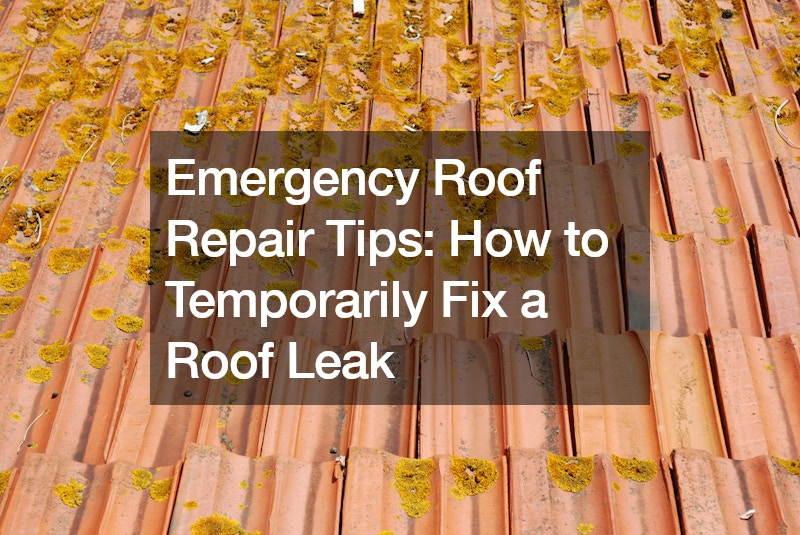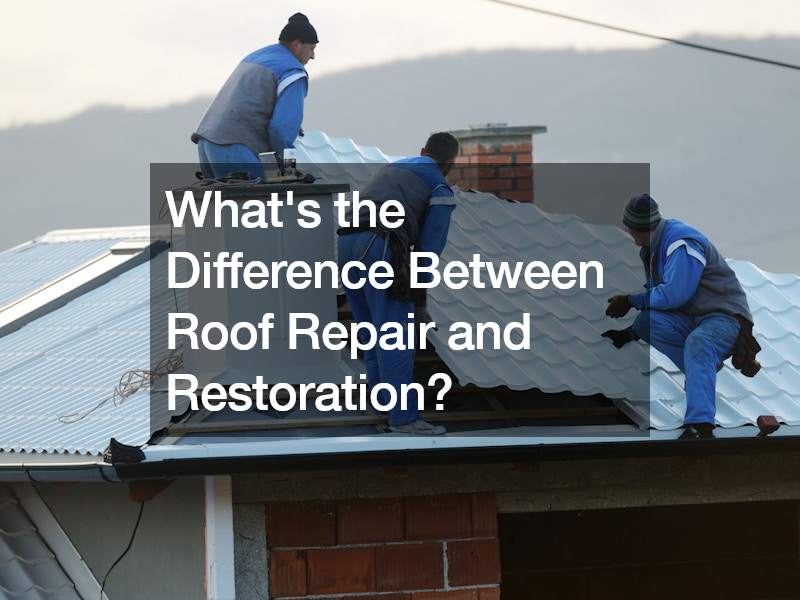Introduction
When faced with a leaking roof, knowing how to temporarily fix a roof leak can be crucial to preventing further damage to your home. Whether it’s due to storm damage or simply wear and tear, a quick and effective temporary repair can buy you time until a professional roofing contractor can assess and repair the damage. In this guide, we will explore the materials needed, steps to take, and common mistakes to avoid when addressing one of the most common roofing jobs: a leak!

1. What materials are needed to temporarily fix a roof leak?
When attempting to temporarily fix a roof leak, you will need a few essential materials to effectively address the issue. These include a tarp or plastic sheeting to cover the damaged area, roofing cement to seal the leak, and roofing nails or screws to secure the tarp in place. Having these supplies on hand can help you quickly and efficiently address the leak and prevent further damage to your roof and home. It’s important to have these materials readily available in case of an emergency. By having these roofing supplies available, you can be prepared to tackle a roof leak as soon as it occurs, minimizing the potential for water damage to your home’s interior and structure.
2. Where is the best place to start when learning how to temporarily fix a roof leak?
Before putting your knowledge of how to temporarily fix a roof leak into practice, it’s crucial to locate the source of the leak. This may require inspecting your roof for visible damage, such as missing shingles or cracked flashing. Once you’ve identified the source of the leak, clear any debris from the area to ensure a clean and secure surface for repair. Debris can impede the effectiveness of your temporary fix and may lead to further damage if not removed. Starting at the source of the leak and working your way outwards can help you effectively address the issue and prevent water from seeping into your home. This methodical approach can help you identify and repair the cause of the leak while also shining a light onto how your stormwater systems may be lacking.
3. How should a tarp be properly installed to cover a roof leak?
When using a tarp to cover a roof leak, it’s essential to measure and cut the tarp to the appropriate size to fully cover the damaged area. This will help create a waterproof barrier and prevent water from entering your home. Secure the tarp in place using roofing nails or screws along the edges to ensure it doesn’t shift or lift in the wind. Adding extra weight, such as heavy objects or sandbags, to the tarp can further prevent lifting and ensure a tight seal. Properly installing a tarp over a roof leak can provide temporary protection until a professional roofing contractor can make a more permanent repair. Taking the time to secure the tarp effectively can help prevent further damage to your home while you learn how to temporarily fix a roof leak.

4. Can roofing cement be used to stop a roof leak temporarily?
Roofing cement can be an effective temporary solution to stop a roof leak and prevent water from entering your home. Apply the roofing cement to the source of the leak using a putty knife, spreading it evenly over the damaged area. Allow the roofing cement to dry completely before exposing it to water, ensuring a secure and waterproof seal. This temporary fix can buy you time until a professional roofing contractor can assess and repair the leak. Using roofing cement to address a roof leak can provide a quick and effective solution to prevent further water damage to your home. Be sure to follow the manufacturer’s instructions for application and drying times to ensure a successful repair.
5. How effective are roof sealants in repairing leaks temporarily?
Roof sealants can be a valuable tool in temporarily repairing leaks and protecting your home from water damage. When choosing a sealant, be sure to select one designed for the specific type of roofing material on your home.
Apply the sealant to the damaged area according to the manufacturer’s instructions, ensuring a proper and secure seal. Monitor the sealed area for any signs of leakage, and reapply the sealant as needed to maintain the repair. Using a roof sealant to address a leak can provide temporary protection and prevent further damage to your home. Regularly inspecting the sealed area can help you identify any issues before they escalate into more significant problems.
6. Are there temporary fixes for roof leaks that can be done from the inside?
In some cases, a roof leak may be addressed from the interior of your home as a temporary solution. Placing a bucket to catch dripping water can help prevent water damage to your home’s interior until a professional roofing contractor can make repairs. Using a sponge or towel to absorb excess moisture can help protect your ceilings and walls from water damage. However, it’s essential to avoid climbing onto the roof if it is unsafe or if you’re not experienced in roof repair.
Taking these precautions from the inside can help minimize water damage to your home while you wait for a professional roofing contractor or emergency tree work specialist. Safety should always be the top priority when addressing roof leaks.
7. How important is it to address a roof leak immediately?
Addressing a roof leak promptly is crucial to preventing further damage to your home’s structure and interior. Delaying repairs can result in extensive water damage, mold growth, and costly repairs.
By addressing a roof leak immediately, you can prevent potential water damage to your home’s interior, including ceilings, walls, and personal belongings. Inspecting and repairing leaks as soon as they occur can help you avoid more significant issues down the line. Reducing the risk of mold and mildew growth is another crucial reason to address a roof leak immediately. Moisture from a leak can create an ideal environment for mold growth, which can be harmful to your health and require professional remediation.
8. Can a temporary roof repair hold up in severe weather conditions?
While knowing how to temporarily fix a roof leak can provide immediate protection, it may not hold up in severe weather conditions. It’s essential to reinforce the temporary fix as needed before storm damage hits to prevent further damage.
Monitoring the repair during and after severe weather events can help you assess its effectiveness and make any necessary adjustments. Be prepared to make additional repairs if the temporary fix fails to protect your home from water intrusion. Working closely with a professional roofing contractor can help you determine the best course of action in severe weather conditions and prevent further damage to your home. Regular inspections and maintenance can help ensure your roof is prepared for any weather event.

9. When should a professional roofer be called in to fix a roof leak?
If the damage to your roof is extensive and beyond what can be fixed temporarily, it’s essential to call a professional roofer. A roofing contractor can assess the damage and recommend the best course of action for repair.
If your roof is under warranty, repairs should be done by a professional to avoid voiding the warranty. Local roofing contractors have the knowledge and expertise to repair your roof correctly and ensure the warranty remains valid.
If safety is a concern due to the height of your roof or the presence of multiple leaks, it’s best to leave repairs to a professional roofer. They have the necessary equipment and training to address roof leaks safely and effectively.
10. Are there any temporary fixes for roof leaks that can be done in the winter?
In the winter months, addressing a roof leak promptly is crucial to prevent further damage from snow and ice. Using a heat gun to thaw frozen roofing materials can help you access and repair the damaged area. Applying roofing cement or sealant in above-freezing temperatures can ensure a secure and waterproof seal. Monitoring the repair closely for signs of leakage or further damage can help you address any issues before they escalate.
Regularly inspecting your roof for damage and making temporary repairs when needed can help protect your home during the winter months. It’s essential to work with a professional roofing contractor to address any significant issues and prevent further damage.
11. What are some common mistakes to avoid when temporarily fixing a roof leak?
One common mistake when temporarily fixing a roof leak is using improper materials that may cause further damage. It’s essential to use materials designed for roof repair to ensure a secure and effective temporary fix. Neglecting to properly clean and prepare the damaged area before making repairs can compromise the effectiveness of your temporary fix. Removing debris and ensuring a clean surface can help the repair adhere properly and prevent future issues.
Failing to monitor the repair for signs of continued leakage or damage can lead to further issues down the line. Regularly inspecting the repaired area can help you identify any issues and make necessary adjustments before they escalate.

12. Is it possible for a temporary roof repair to extend the life of a roof?
While knowing how to temporarily fix a roof leak can provide immediate relief, this is not a long-term solution for roof damage. Temporary fixes can buy you time until a professional roofing contractor can make a more permanent repair or replacement.
Proper maintenance and regular inspections can help prolong the life of your roof and prevent significant issues from arising. Monitoring the roof for further damage and being prepared to make a permanent repair as needed can extend the life of your roof. By taking proactive measures, knowing how to temporarily fix a roof leak, and working with a professional roofing contractor, you can protect your home and prolong the life of your roof. Regular maintenance and timely repairs can help prevent costly damage and ensure the longevity of your roof.
How to Find the Right Team for the Job
You can’t afford to settle for the first team of roofers you can find on Google. Your roof is a huge investment, so put in some time and effort into finding the right team for you! Fixing a temporary leak os one thing, but providing a permanent solution should be in the hands of the pros.
Word of Mouth
Ask your friends, family, or neighbors about their go-to local roofing business. Knowing how to temporarily fix a roof leak is a great skill to have, but having a reliable team on standby is key to addressing your roof problems ASAP. Facebook is an excellent tool for locating local businesses that others in your area recommend.
Website Highlights
Unfortunately, even unexperienced roofers will probably have a website that’s gorgeous on the outside. To find a quality business, you need to look on their website for very specific details, such as warranty information, client reviews, and, most importantly, a gallery of their past work. Look for homes that have similar features to yours to confirm that they can get your job done. If they have no experience, gallery, or reviews listed, they may not even know how to temporarily fix a roof leak! Always verify credentials before making a large investment such as a full roof replacement.
Conclusion
Knowing how to temporarily fix a roof leak can be invaluable in preventing further damage to your home and belongings. By using the right materials, following proper procedures, and addressing leaks promptly, you can protect your home from water damage and mold growth. It’s crucial to work with a professional roofing contractor if the damage is extensive or if safety is a concern. Local roofing contractors have the expertise and knowledge to address roof leaks effectively and ensure the integrity of your roof. Remember that quick action is key when dealing with roof leaks, as delaying repairs can lead to costly damage and health risks. By staying proactive and addressing leaks promptly, you can protect your home and ensure its longevity for years to come.




